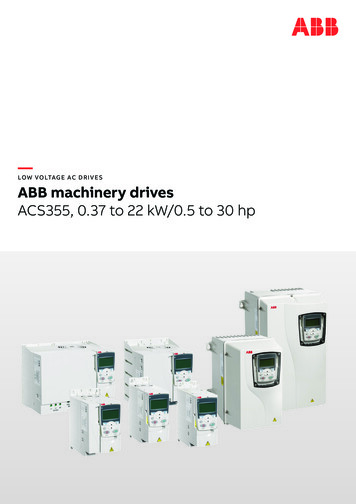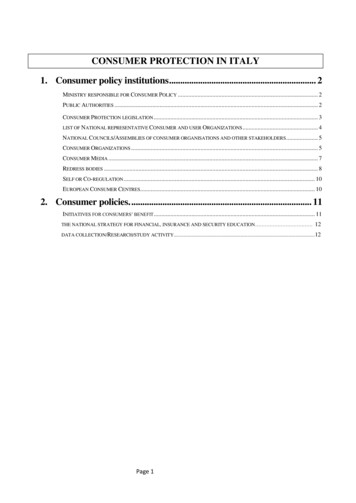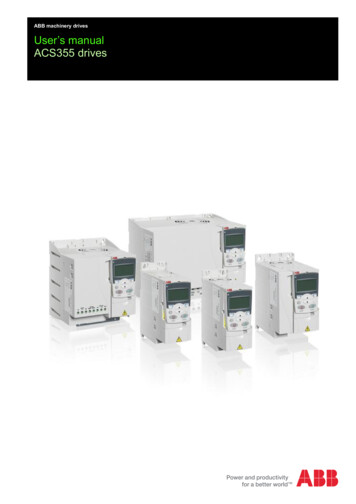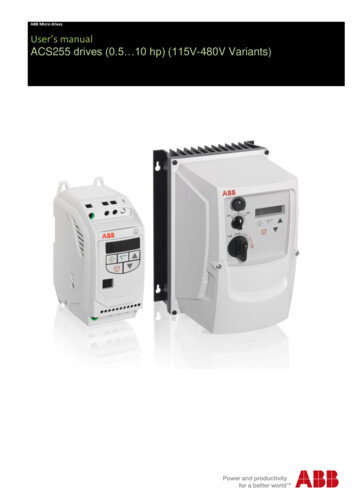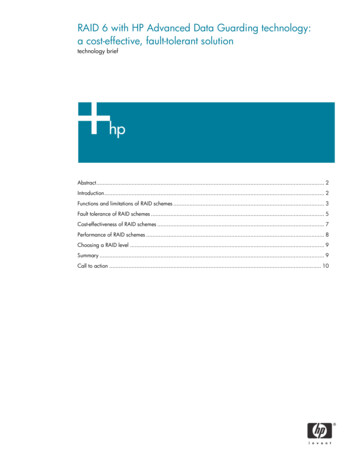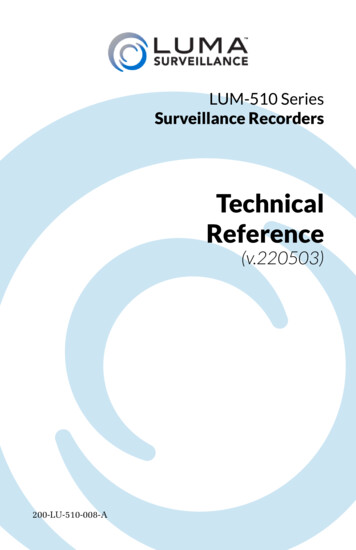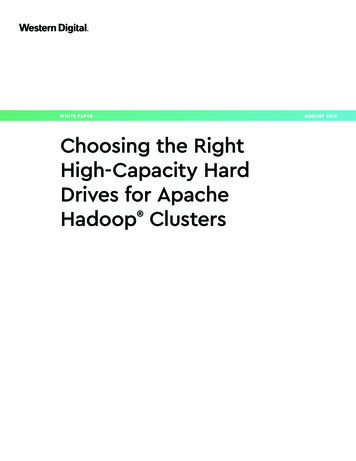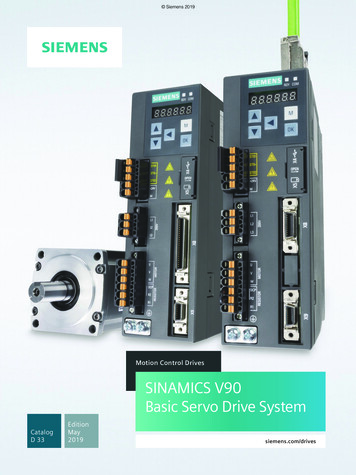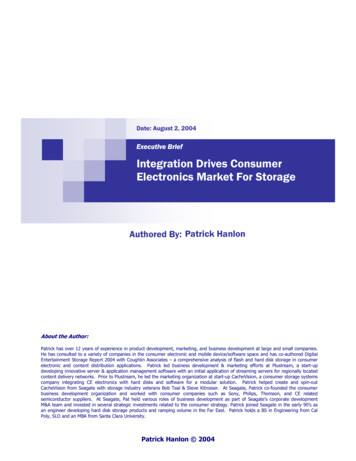
Transcription
Date: August 2, 2004Executive BriefIntegration Drives ConsumerElectronics Market For StorageAuthored By: Patrick HanlonAbout the Author:Patrick has over 12 years of experience in product development, marketing, and business development at large and small companies.He has consulted to a variety of companies in the consumer electronic and mobile device/software space and has co-authored DigitalEntertainment Storage Report 2004 with Coughlin Associates – a comprehensive analysis of flash and hard disk storage in consumerelectronic and content distribution applications. Patrick led business development & marketing efforts at Plustream, a start-updeveloping innovative server & application management software with an initial application of streaming servers for regionally locatedcontent delivery networks. Prior to Plustream, he led the marketing organization at start-up CacheVision, a consumer storage systemscompany integrating CE electronics with hard disks and software for a modular solution. Patrick helped create and spin-outCacheVision from Seagate with storage industry veterans Bob Teal & Steve Kitrosser. At Seagate, Patrick co-founded the consumerbusiness development organization and worked with consumer companies such as Sony, Philips, Thomson, and CE relatedsemiconductor suppliers. At Seagate, Pat held various roles of business development as part of Seagate's corporate developmentM&A team and invested in several strategic investments related to the consumer strategy. Patrick joined Seagate in the early 90’s asan engineer developing hard disk storage products and ramping volume in the Far East. Patrick holds a BS in Engineering from CalPoly, SLO and an MBA from Santa Clara University.Patrick Hanlon 2004
Integration Drives Consumer Electronics Market For StorageConsumer Hard Disk Primed for Attractive GrowthWith the world moving toward increased digital content, the consumer electronics market provides an enormousgrowth opportunity for hard disk providers and consumer electronic companies. The total market for consumerelectronic products with hard disks exceeded 18M units last year and forecasts show good growth over the next fiveyears. With this opportunity comes the need for higher levels of system integration that will change the industry,standards, and strategic partnerships. Those that lead the change will be rewarded well for the risks taken to growthe market. Followers will be left with the expense of integration but commodity returns. This document outlinesthe primary alternatives for integration, as well as noting challenges and requirements. Put simply, this briefintroduces a high-level roadmap to consumer electronics storage integration.Alternative Approaches of Integrating CE & Hard Disk ElectronicsThere are six primary approaches to the integration of CE Electronics with Hard Disk electronics. Each method ofintegration has its benefits and challenges and will be adopted to match market opportunity.Method 1METHOD 1Standard Interface - Integrated By CE Device ManufacturerConsumer Electronics manufacturer/ODM purchasesstandard disk drives from a hard disk supplier andintegrates the hard disk drive as a component intothe final system. This is the current state of theindustry as PC hard drives are leveraged for theconsumer market. Each consumer electronic productplatform group must develop/optimize drivers, filesystem, and power management features associatedwith the hard disk. The cost structure of thisarchitecture will limit market growth due to a higherbill of materials cost.Standard Interface(ATA, SATA, CF, SDIO)Motor/VCMCE HostLogicHard Disk E HostLogicSDRAMBufferCE Specific ApplicationSDRAMBufferFlashHard Disk PCBACE "Host" DeviceMethod 2Hard disk is integrated with core CE electronics andsold as an application specific module to an ODM/CEManufacturer. This method has been attempted inthe past without success due to a questionablevalue proposition to CE Mfg’s. It was less expensiveto use method “1” and incur the additionaldevelopment costs. This approach looks promisingfor portable/mobile applications where integrationlowers cost, speeds time to market, and there is ahuge gap in competencies associated with theintegration of disk drives into these products.Method 2Application Specific CE ModuleInterface toHost Systemwith APIStandard Interface(ATA, SATA, CF, SDIO)Motor/VCMHard Disk tronicApplication Logic(eg mp3 Player)SDRAMBufferCE Specific ApplicationSDRAMBufferFlashHard Disk PCBAPatrick Hanlon 2004Email: Patrick@patrick-hanlon.comSDRAMBufferCE Module DaughterboardPage 2
Integration Drives Consumer Electronics Market For StorageMethod 3Method 3This approach to integration pushes hard drivesystem electronics from the hard disk assembly ontothe host system. A new (currently proprietary)interface is used to transmit raw NRZ data to thehost system. This approach has merit in that totalsystem cost can be reduced through shared memoryand CPU resources. But, the increased effort tointegrate hard disk electronics into many CE hostsystem platforms will be challenging and thedevelopment costs may outweigh the unit costreductions. The proprietary nature of the interfacewithout multiple supplier compatibility will also posechallenges to this approach.Storage Module - HDD Electronics Integrated with CE HostProprietary Serial InterfaceMotor/VCMCE Host Sytem with HDDLogic & FirmwareRead/WriteServoCPUECCSDRAMBufferFlashCE Application & LogicHard Disk PCBAFlashSDRAMBufferCE Host System PCBAMethod 4Hard disk SOC (System on a Chip) designedspecifically for CE applications. The approach hasthe advantage that it’s designed to optimize powerand still retain a standard interface that can allowfor the drive to be either embedded or removable.These drives have lower data rates and a smallinternal buffer in the SoC to conserve footprint inmobile power sensitive applications. It enables thehard drive system and RTOS to operate separatelyfrom the integrated CE application, enables paralleldevelopment of hard disk and CE applicationfirmware and logic, and it enables a clear division intesting and failure analysis that minimizes disruptionto current hard drive production back-end testinginvestments. CE application software architecturecan be leveraged off existing PC code, with reducedcaching, SMART, etc. commands.Method 4Hard Disk SOC w/Embedded Flash & CE OptimizationStandard Interface(eg SDIO, etc.)Motor/VCMinc. PowerManagementCE HostLogicHard Disk SOCInterfaceCE hCE Specific ApplicationHard Disk PCBACE "Host" DeviceMethod 5AMethod 5AHard disk SOC (System on a Chip) with largerembedded processor that has enough cycles to runspecific CE applications synchronous with the diskdrive embedded system. This approach hassignificant merit for more mature and standardsbased applications such as mp3 recording andplayback. Semiconductor providers must provideintegration for this approach to be successful. TheCE application portion will be pre-tested at the chiplevel so that standard hard drive production andtesting procedures can be utilized.Hard Disk SOC for CE Apps - Single CPU W/Semi Company IntegrationStandard Interfacefor Specific Application(eg SDIO, etc.)Hard Disk SOCInterfaceServoCPUControl/FeedbackInterface(LCD Keypad, etc.)ECCRead/WriteEmbeddedFlashAudio DACCE Specific ApplicationMotor/VCMinc. PowerManagementSDRAMBufferHard Disk PCBA w/CE ApplicationPage 3Patrick Hanlon 2004Email: Patrick@patrick-hanlon.com
Integration Drives Consumer Electronics Market For StorageMethod 5BA variation of method 5A is for the CE manufacturerto port their applications to the CPU on this harddisk SOC independently. This has the advantagethat it only requires an upgrade in CPU performancebut has some severe limitations and potential issuesfor system developers. Writing to a proprietaryRTOS will make it difficult for CE manufacturers todevelop products. CPU interrupt priority set to favorservo/drive functions over the CE application maylead to end user performance issues. Hard disktesting processes and failure analysis may beadversely affected by this approach. In addition,the independent development of the CE system andthe hard disk may be increased in difficulty.Method 5BHard Disk SOC for CE Apps - Single CPU W/CE Company IntegrationStandard Interfacefor Specific Application(eg SDIO, etc.)Hard Disk o DACControl/FeedbackInterface(LCD Keypad, etc.)CE Specific ApplicationSDRAMBufferMotor/VCMinc. PowerManagementHard Disk PCBA w/CE ApplicationMethod 6Method 6Hard disk SOC with second CPU and custom logic forCE applications. As unit volumes in key segmentsgrow, this approach is the most likely long-termoutcome as it balances the needs of system levelcost reduction with the dynamics of the value chain.This approach has many advantages. It enables thehard drive system and its RTOS to operateseparately from the integrated CE application,enables parallel development of hard disk and CEapplication firmware and logic, and it enables a cleardivision in testing and failure analysis that minimizesdisruption to current hard drive production back-endtesting investments.Hard Disk SOC for CE Apps - Multi CPU & Custom CE LogicStandard Interfacefor Specific Application(eg SDIO, etc.)CE Hard Disk SOCHard Disk SpecificControl/FeedbackInterface(LCD Keypad, etc.)Read/WriteServoCPUECCCE App SpecificSDRAMBufferFlashCE App LogicCPUCE InterfaceMotor/VCMSDRAMBufferHard Disk PCBA w/CE ApplicationPatrick Hanlon 2004Email: Patrick@patrick-hanlon.comPage 4
Integration Drives Consumer Electronics Market For StorageItems to Consider on the Path to Integration:Integration will Follow progressive steps to balance investment and return potentialThe path to higher levels of integration will follow progressive steps that match market demand withreturn potential. Significant investment from industry leaders is required to reach each step of integrationthat must be justified by sufficient return to justify the risks.Approaches 5A and 6 will prevail long term and can co-exist depending on the applicationIntegration approaches 5A and 6 will prevail longer term because they remove the most cost whilebalancing the needs of the value chain while minimizing disruption to current production and testinginvestments. These approaches also provide the best value in terms of size and power reduction wherecost is not the only factor driving integration.Integration must provide flexibility to differentiateHigher levels of semiconductor integration must still provide adequate flexibility for hard disk andconsumer electronic manufacturers to differentiate their products in the marketplace. Each consumerelectronics company must have enough flexibility to position their product in the market in a way thatmatches their brand and target customers.Collaboration of leaders in value chain necessary for successHigher levels of integration will no doubt challenge some suppliers’ existence in the value chain and willrequire that leaders work together to make the path to integration swift and financially rewarding for thestrong. Partners must work together to realistically balance core competencies, partition integrationcomponents with consideration to capital investments in manufacturing and testing, and drive theestablishment of new standards.Mobile products will see integration sooner than stationary productsMobile products will see higher levels of integration sooner than stationary because of the size and powerconsumption constraints in addition to pure cost reduction requirements. The current volume shipmentsof smaller form factor storage devices is also much lower than 3.5 inch and 2.5 inch products where thereis already an economy of scale.Critical Step in Market Growth from Niche to Mass Market ProductsConsumer electronics market growth for disk drives is highly dependent on higher levels of integration for long termgrowth. This is an iterative cycle for the industry in that integration drives market growth and market growthdrives the attractiveness to invest in higher levels of integration. Integration will follow steps of increasingcomplexity that are rewarded with higher margins for the first generation but become commodity features as thenext step of integration and features are added to the system. Integration is a key factor in restoring profitpotential to the value chain while lowering system costs and increasing market growth.Coughlin Associates to Publish In-Depth Report on CE/HDD IntegrationThis Executive Brief has introduced the primary methods of hard disk and consumer electronic systems integration.Coughlin and Associates will publish an in-depth report on the topic. An outline and pre-order information areavailable by contacting the author at email address patrick@patrick-hanlon.com. Please feel free to email theauthor with any comments or question you may have before the in-depth report is released.Page 5Patrick Hanlon 2004Email: Patrick@patrick-hanlon.com
Significant investment from industry leaders is required to reach each step of integration that must be justified by sufficient return to justify the risks. Approaches 5A and 6 will prevail long term and can co-exist depending on the application
